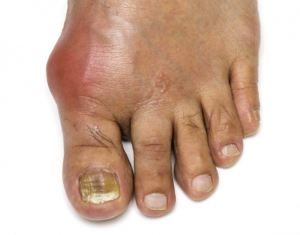 What is gout and how is it caused?
What is gout and how is it caused?
Gout is a type of inflammatory arthritis that results from a high concentration of uric acid in our blood. Uric acid builds up in our bodies from the food we eat as part of a regular diet. It’s a by-product of our bodies breaking down purines – chemicals naturally found in our food. Sometimes, the kidneys have difficulty processing and getting rid of uric acid at a normal rate, and sometimes the production of uric acid is just too high. Either way, we’re left with much more uric acid left in our blood than we should normally have.
A gout attack happens when the uric acid crystallises in a joint and for 90% of those with gout, this will happen at their big toe among other joints. This is because uric acid crystallises in cooler temperatures and our feet are often the coolest part of our body. It is these stiff crystals that can cause severe pain and discomfort.
Otherwise known as the Rich Man’s Disease
Long ago, gout was referred to as the ‘Rich Man’s Disease’ because it was noted that gout primarily affected people that were wealthy. This is because certain (expensive) foods contain much higher levels of purines – like red meats, shellfish, red wine and beer – which the rich could afford much more of. This still holds true today, in the context that if you’d like to lower your chance of having a flare-up of gout, you should cut back on these more expensive foods.What are the symptoms?
Gout can feel excruciatingly painful during an ‘attack’ or ‘flare up’. Symptoms generally include:- Intense pain
- Sudden onset, day or night
- Swelling
- Affected joint can be warm and red








